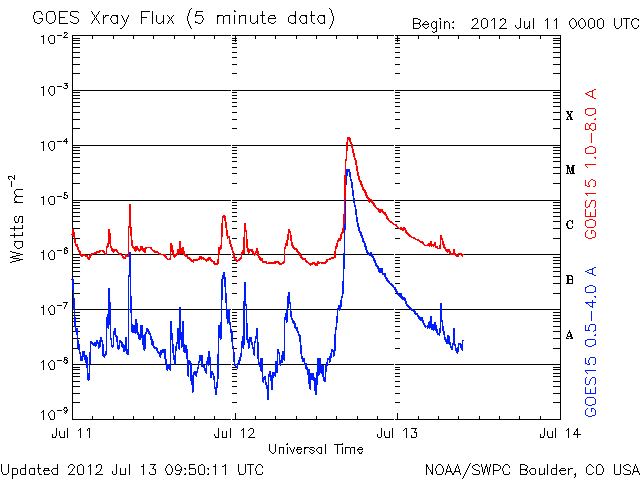Space Weather Alert - 13th July 2012
What Has Happened?
Geomagnetic activity is expected to reach storm levels tomorrow (14th Jul 2012) resulting from increased solar activity with an increased chance of seeing aurora displays at lower than normal latitudes.
Yesterday evening, the Sun produced a relatively large (X1-class) solar flare: a sudden release of stored magnetic energy in the Sun's atmosphere. Associated with this event was a rapid increase in the measured X-rays and energetic particles measured by satellites in Earth's orbit, which may have resulted in some deterioration in radio communications.
See video of the event from Solar Dynamics Observatory
(from spaceweather.com).
The flare was also associated with a Coronal Mass Ejection (CME), a fast moving cloud of gas that was seen leaving the Sun shortly after the flare. Due to the location of the flare close to the centre of the Sun's disc, this CME was likely to be directed towards the Earth. This has been confirmed by satellite imagery. When this CME reaches the Earth, it is likely to trigger a geomagnetic storm and enhanced auroral displays. Analysis suggests that the CME will reach the Earth sometime tomorrow but its exact time of arrival is not certain.
Assuming clear dark skies, there is an increased chance of seeing the aurora in the hours following the arrival of the CME, particularly at high latitudes but also lower depending on the strength of the storm.
The active region on the Sun that produced the flare is still volatile and further flares and CMEs are possible over the coming days.
See BGS Real-time estimated Ap for global geomagnetic activity levels.
Sign-up to receive Geomagnetic Disturbance Alert emails.
Follow us on Twitter:
Follow @BGSauroraAlert for more occasional aurora alerts.
Follow @BGSspaceWeather for daily space weather forecasts.
How often does this happen?
Space weather follows a natural cycle of activity known as the solar cycle and traditionally measured by the sunspot number. After a lengthy minimum, solar activity is increasing again and soon the Sun will once again be at the peak of its activity. The number of magnetic storms follows a similar cycle with its peak usually lagging behind the solar cycle by one or two years.
It is still scientifically very difficult to predict with any accuracy when a space weather event will occur and how large an impact it will have on the Earth. Research, for example funded through the UK Natural Environment Research Council, is continuing into space weather prediction.
We do know however that once a major solar eruption has occurred, that any space weather impact on the Earth will follow from hours to a few days later.
What is BGS’ Role in Monitoring and Predicting Space Weather?
The BGS Geomagnetism team measures, records, models and interprets variations in the Earth’s natural magnetic fields, across the world and over time. Our data and expertise help to develop scientific understanding of the evolution of the solid Earth and its atmospheric, ocean and space environments. We also provide geomagnetic products and services to industry and academics and we use our knowledge to inform and educate the public, government and the private sector.
The Geomagnetism team provides 24/7 monitoring of geomagnetic activity, 3-day ahead magnetic activity forecasts, and post-event analysis of storm impacts on technology, including the UK power network.
Background
One way that scientists measure the strength of solar activity is through the brightness of any solar flare that accompanies each event.
Table 1 shows the strength of the top 10 flares known since 1970s. The recent flare is at least 10 time smaller than these.
Rank |
Year/Month/Day |
X-Ray Class |
|---|---|---|
1 |
2003/11/04 |
X28+ |
2 |
2001/04/02, 1989/08/16 |
X20.0 |
3 |
2003/10/28 |
X17.2 |
4 |
2005/09/07 |
X17 |
5 |
1989/03/06, 1978/07/11 |
X15.0 |
6 |
2001/04/15 |
X14.4 |
7 |
1984/04/24, 1989/10/19 |
X13.0 |
8 |
1982/12/15 |
X12.9 |
9 |
1982/06/06, 1991/06/01, 1991/06/04, 1991/06/06, 1991/06/11, 1991/06/15 |
X12.0 |
10 |
1982/12/17, 1984/05/20 |
X10.1 |
Rank |
Date |
Peak Rate-of-Change (nT/min) |
|---|---|---|
1 |
13th March 1989 |
1079.6 |
2 |
8th November 1991 |
804.1 |
3 |
30th October 2003 |
656.5 |
4 |
21 October 1989 |
618.6 |
5 |
1st November 1991 |
515.2 |
Glossary
- BGS
- The British Geological Survey is one of the Natural Environment Research Council's Research Centres.
CME or Coronal Mass Ejection- The eruption of a portion of the outer atmosphere of the Sun into space, caused by rapid changes in its magnetic field. Often occurs along with a solar flare.
- Coronal Hole
- A region in the Sun’s outer atmosphere (corona) where hot material can flow unrestrained by its magnetic fields out into space.
- Flare
- Energy released by the explosive reorganisation of magnetic fields within the Sun's atmosphere.
- High Speed Stream
- A fast moving stream of solar wind, responsible for magnetic storms.
- Magnetogram
- The variation, minute by minute, of the strength and direction of the Earth’s magnetic field. Measured in units of nano-Tesla (for the strength of the field) or in degrees (direction of the field).
Solar Wind- The ever-present expansion of the Sun’s hot outer atmosphere into the solar system, which carries space weather within it.
Sunspot- A region of intense magnetic field in the Sun's visible outer atmosphere often associated with flares and CMEs.




